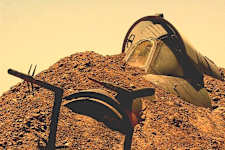One month after a prolific lake-effect snow event brought Buffalo and surrounding areas to a standstill, yet another round will hit over the holiday weekend, and AccuWeather experts say the blizzard will be every bit as severe.
By Alex Sosnowski, AccuWeather senior meteorologist
Published Dec 23, 2022 11:50 AM EST | Updated Dec 23, 2022 12:14 PM EST
The same powerful storm that brought blizzard conditions and severe cold to a large portion of the central United States will continue to spin close enough to the Upper Midwest to create a major lake-effect snow event this Christmas weekend. For many locations, conditions will be dangerous and life-threatening, AccuWeather meteorologists warn.
"In Buffalo, this storm will likely at least jump near the top of the list of worst blizzards in the city’s history, if not even becoming the worst," AccuWeather Meteorologist Jake Sojda said. "Four to 6 feet of snow will fall by Sunday and coupled with wind gusts approaching hurricane force [74 mph or greater] to create enormous drifts and impossible travel."

A blizzard is defined by the National Weather Service as sustained or wind gusts to 35 mph or greater with visibility of one-quarter of a mile or less in snow or blowing snow for at least three consecutive hours.
"Power outages are possible across the City of Buffalo and the Western New York region throughout the duration of the storm," Buffalo Mayor Byron W. Brown said in a press conference earlier this week. "This potentially dangerous storm is expected to bring hazardous conditions to the area which will impact the entire city."

Winter storm is packing a punch: More than 1 million utility customers were without power across the central and eastern United States as of mid-morning on Dec. 23, 2022. (Poweroutage.us)
During the Blizzard of '77, high winds helped to blow snow from the then-frozen Lake Erie onto the shoreline and into Buffalo from late January to early February. Mountainous drifts occurred.
In the situation this weekend, the lake is not yet frozen over, but the open waters can fuel a tremendous amount of lake-effect snow, considering the frigid conditions in the single digits and teens F much of the time.
More recently, the snow event from mid-November brought a storm total of 81.2 inches in Hamburg and 80 inches in Orchard Park, New York. These locations are towns south of Buffalo. However, the band of heaviest snow will aim farther north with a natural snow cannon from Lake Erie likely to impact the downtown area and some of the towns on the Niagara Peninsula.
"The heavy snow across the Great Lakes will be coupled with roaring winds," Sojda said. "Blizzard conditions could persist for over 48 hours in some areas downwind of the Great Lakes. Significant blowing and drifting is expected and will make measuring snow very difficult."

In some cases, it will be nearly impossible to know exactly what the snow totals are due to extreme drifting of snow.
"Even areas around the Great Lakes that don’t receive much snow can experience whiteout conditions at times, especially in open areas," Sojda said.
"From Friday through Saturday night, travel will not only be difficult and dangerous due to blizzard conditions, but it could also be life-threatening," Sojda warned. For anyone that attempts to venture out and travel amid the storm, there is a high risk of becoming stranded and buried in snow.
In the heaviest snow bands that set up off the Great Lakes, snowfall rates of 6 inches per hour can occur. The exceptional rate of snow may last for many hours. When combined with the high winds and powdery nature of the snow, massive drifts deep enough to cover single-story homes and completely bury vehicles are likely.
Where the power goes out, "people could be stuck in homes with no heat or running water," Sojda said. There is the risk that exhaust pipes from those stuck in cars or homes could become blocked, which can substantially increase the risk of carbon monoxide poisoning.

Feet of snow will also pile up to the east of Lake Ontario this Christmas weekend as well, where conditions very similar to that of Buffalo are likely in some communities.
The western Great Lakes will certainly get their fair share of lake-effect snow through the holiday weekend as well, Sojda said.
"One to two feet is likely by Sunday in western Michigan near the lakeshore. Some parts of northern Lower Michigan and the Upper Peninsula can see as much as 2 to 4 feet where heavy snow is the most persistent," he said.
The amount of snow that falls around the Great Lakes, especially off of lakes Erie and Ontario, may require heroic means to remove for some communities to have access to highways and emergency services in the days ahead. It could take days for some neighborhoods to dig out.
Fortunately, the weather will begin to cooperate after this weekend with a day-to-day warming trend and a break from major storms coming next week. Temperatures will climb well above freezing across a large area of the country later next week and for the New Year's weekend.
More to read:
Want next-level safety, ad-free? Unlock advanced, hyperlocal severe weather alerts when you subscribe to Premium+ on the AccuWeather app. AccuWeather Alerts™ are prompted by our expert meteorologists who monitor and analyze dangerous weather risks 24/7 to keep you and your family safer.







No comments:
Post a Comment